Rain can also cause Soil Erosion, Forest Degradation, and Global Warming
What do you know about rain? Perhaps the word rain is familiar to be heard, the rain coming at a certain time and giving importance to the life of living beings. So far we only know that rain is just a spot in front of a house that carries millions of drops and falls to the ground. The rainfall process is actually very scientific, one form of the incidence of precipitation falling rain water or liquid from the earth's atmosphere in liquid form to the surface of the earth. Given the thick and thick atmosphere of the atmosphere, and lying on the surface of the earth.
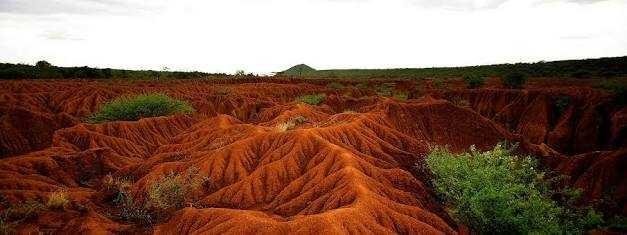
Rain is a liquid precipitation, in contrast to non-liquid precipitation such as snow, iceberg and slit. Rain requires the presence of a thick layer of atmosphere to meet temperatures above the melting point of ice near and above the Earth's surface. On Earth, rain is the process of condensing water vapor in the atmosphere into water grains that are heavy enough to fall and usually arrive on land. Two processes that may occur together can push the air getting saturated before the rain, which is air cooling or adding moisture to the air. Virga is precipitation that falls to Earth but evaporates before it reaches the land; this is one way of saturation air. Precipitation is formed through a collision between water grains or ice crystals with clouds. Raindrops have a variety of sizes ranging from precise, like pancakes (large grains), to small balls (small grains).
In addition, rain can also be interpreted in the form of condensation process, the change of liquid form into solids that form clouds, also has a heavy mass falling to earth. Cold air or low temperatures also play an important role in the rain down to earth. In addition to the steam state of water that continues to grow erratically makes the rain water droplets to vary, there are large droplets and also there are small droplets.
The humidity that moves along the three-dimensional temperature and humidity difference zone called the weather front is the main method in making rain. If at that moment there is enough moisture and upward movement, the rain will fall from a convective cloud (cloud with a strong upward motion) like a cumulonimbus (thunderstorm) that can accumulate into a narrow rainbreak. In mountainous areas, heavy rainfall can occur if the upper flow of the valley rises at the top of the surface wind at altitudes that force moist air to condense and fall as rain along the side of the mountains. On the underside of the mountain breeze, desert climates can occur due to the dry air resulting from the flow of the valleys that leads to warming and drying of air masses. The movement of monsoon trumps, or intertropical convergence zones, brings the rainy season to a savanna climate. Rain is the main source of fresh water in most parts of the world, providing conditions suitable for the diversity of ecosystems, as well as water for hydroelectric power plants and irrigation fields. Rainfall is calculated using a rain gauge. The amount of rainfall is calculated actively by weather radar and passively by weather satellites.
Some explanations about rain types:
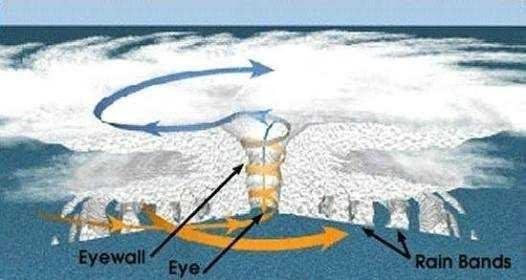
- Cyclone Rain
Cyclone rains occur due to hot air, high ambient temperatures and simultaneous with winds that spin. Usually this occurs in areas that cross the equator. This is because there is a meeting between the wind from various angles. After that the wind rises, then the clumps on the clouds that are on the equator.
After the cloud reaches its saturation point, this rain will start with a very dark cloud, then rain down and wet the entire surface of the earth that gives a positive impact on all living creatures that live on earth, and also eagerly awaited by living things on earth.
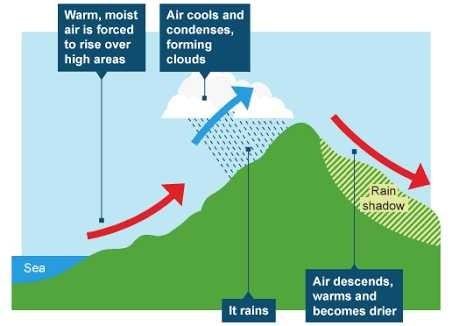
- Orographic Rain
This is the rain that occurs because of the wind that contains water vapor, then the direction of the movement horizontally. Wind trips must pass through the mountains causing the wind temperature to cool the condensation process.
Then the formation of water droplets that begin to settle, so it will cause rain on the slopes facing toward the arrival of the wind that usually moves horizontally, and the wind will blow continue to climb the mountains and wind down the slope. That the humidity on the slopes of the back of the coming wind will not rain. Then because of the ever-increasing water mass, unable to get carried away by the wind, the rain descended on the mountain.
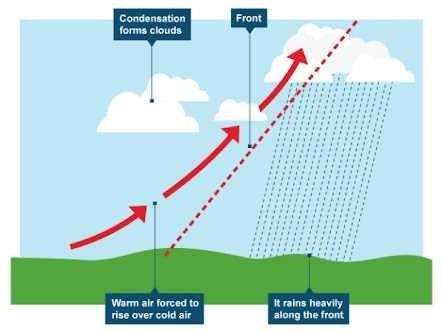
- Frontal Rain
This type of rain can occur due to a meeting between the masses of cold air and low temperatures, as well as the masses of hot air and high temperatures. When encountered, low temperatures and cold air mass are heavier than high temperatures and hot air masses, causing steam in cold air to drop very much above the earth's surface. Usually the differences in the two masses meet in front of the field which is one of the easiest places to happen condensation and cloud formation. That is why the name of this rain is Frontal Rain.
Usually Frontal Rain occurs in areas located in latitudes of astronomy or the northern and northern mid-latitudes. If the tropics experience this rain, then the way out is not just the usual rain but until the hail. This can happen because of exposure to sunlight that causes water in the ocean, swamps and other places to rise in convection, causing condensation and cloud formation. Because the airspace rising convection is very cold, temperatures below 0⁰ Celsius also fell. The rising water becomes frozen, and when the cloud reaches its saturation point, rain falls into the tropics. Usually not just water that goes down, ice crystals will also go down.
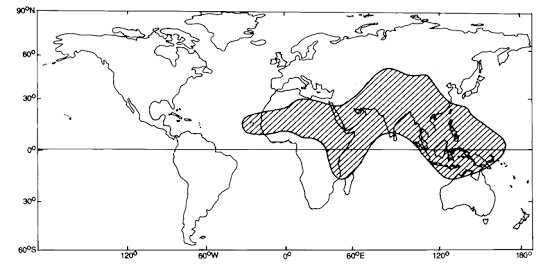
- Zenithal Rain
This rain occurs as a result of a meeting of northeast winds with southeast pasig wind, thus forming frozen and rising vertically, due to exposure to cloud heating. This causes clouds that have heavy mass to experience a decrease in temperature that causes the condensation process. Since the water of the blob has reached its saturation point, it finally rains. Because the location of this rainfall is above the imaginary line of the equator, it is named after zenithal rain. Regions are usually present with zenithal rain that has a tropical climate with high solar radiation intensity, because almost every year get irradiation.
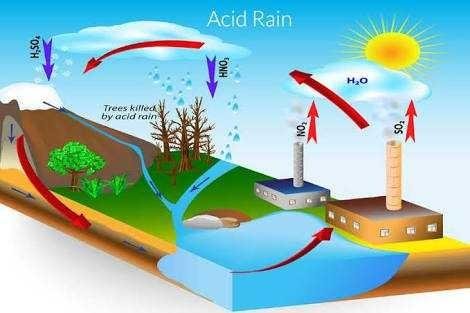
- Acid Rain
Usually the rain has a neutral ph (7). But there is also rain that has low ph, which is under five or six degrees of acidity. This is called acid rain. This can happen when carbon dioxide (CO2) in the air can dissolve with rain water. Then rainwater that initially has a weak acid ph (6) reacts with CO2 or carbon dioxide earlier and the result is water that will increase the acid. Water that has a ph below 5 rises to the cloud and becomes a clot. When the cloud mass has crossed the saturation limit, it will fall to the surface of the earth.
The benefits of acid rain are able to accelerate the dissolution of minerals present in the soil required by flora and fauna. Unfortunately this acid rain brings a bad impact on humans, which speeds up the corrosion process in iron. If you are passing billboards installed in a porous store, this is one proof of acid rain, it becomes very dangerous if there is always acid rain in the place of many bridges. Because it could have a bad impact on the bridge and on the bridge grip.
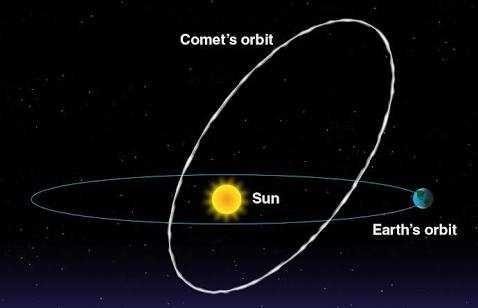
- Meteor Rain
Meteor showers will occur at sunset, then a percentile when it is clear that the solar system like Planet Venus, Saturn, Mars, and the crescent moon in the west together. Perseid is one of the names of the constellation Perseus. Many people assume that this meteor shower comes from the direction of the emergence of the constellation.
Falling meteor speeds can reach 60 kilo meters per hour with bright and long light conditions. The presence of this meteor shower offers another beauty, the emergence of a fireball. When you see bright and bright lights burning among other meteors, that's what is called a fireball.
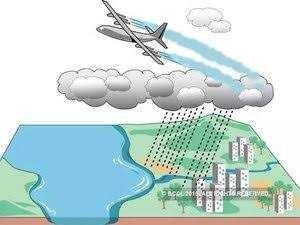
- Artificial Rain
Artificial rain is rain that is made directly by humans with the technique of adding rainfall. The trick with cloud seeding, or known as cloud seeding or make clumps of clouds and seeds that give effect to rain. This is often done in areas that require natural rain, but unfortunately the rain does not go down.
How to reduce this rain through the process of physics, ie by involving collisions and coalescence, then with the process of formation of ice or nucleation. Then the selection of clouds that have enough water content. Its function is the mass that is added enough to bring down rain to the surface of the earth that gives a positive impact on human life. As in the function of the lake for human life in water that is filled due to the decrease of steady rain so as not to cause drought.
The current rain measured carefully and measured in diameter are:
Drizzle Rain: usually called randomized with a diameter <0.5 mm
Snow: made of ice crystals of various sizes where the temperature <0⁰ Celsius
Rain ice cubes: usually down at high temperatures and hot weather, but the ice is still below 0 ° Celsius
Heavy rain: this is called rain with temperatures above 10⁰ Celsius and has a diameter of about 7 mm
Here is the type of rain and rain shape by size. Heavy rain and rain can also cause:
Avalanche
Deforestation
The cause of global warming
The impacts of urban hot islands encourage increased rainfall in numbers and intensity under the urban wind. Global warming also leads to changes in rain patterns around the world, including the rainy atmosphere in eastern North America and the dry atmosphere of the tropics. Rain is a major component of the water cycle and the primary provider of freshwater on the planet. The average annual global rainfall is 990 milimetres (39 in). Clustering systems such as the Köppen climate clustering system use annual mean rainfall to help differentiate climatic areas. Antarctica is the driest continent on Earth. In other regions, the rain has also been down with methane, iron, fluorescent, and sulfuric acid.


Note: All letters and numbers are mine, but the picture I got from google, I just use it to connect from my writing.
You just planted 0.02 tree(s)!
Thanks to @youngky
We have planted already 5271.59 trees
out of 1,000,000
Let's save and restore Abongphen Highland Forest
in Cameroonian village Kedjom-Keku!
Plant trees with @treeplanter and get paid for it!
My Steem Power = 20714.11
Thanks a lot!
@martin.mikes coordinator of @kedjom-keku
This post has received a 1.96 % upvote from @speedvoter thanks to: @youngky.
This post has received a 5.18% upvote from @msp-bidbot thanks to: @youngky. Delegate SP to this public bot and get paid daily: 50SP, 100SP, 250SP, 500SP, 1000SP, 5000SP Don't delegate so much that you have less than 50SP left on your account.
You got a 1.27% upvote from @minnowvotes courtesy of @youngky!
You got a 0.80% upvote from @mercurybot courtesy of @youngky!
You got a 2.39% upvote from @buildawhale courtesy of @youngky!
If you believe this post is spam or abuse, please report it to our Discord #abuse channel.
If you want to support our Curation Digest or our Spam & Abuse prevention efforts, please vote @themarkymark as witness.
Very nice picture